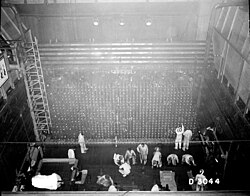B Reactor | |
 The face of B Reactor during construction. | |
| Location | About 5.3 miles (8.5 km) northeast of junction of State Route 24 and State Route 240 on the Hanford Site |
|---|---|
| Nearest city | Richland, Washington |
| Coordinates | 46°37′49″N 119°38′50″W / 46.63028°N 119.64722°W |
| Area | 9.5 acres (3.8 ha) |
| Built | June 7, 1943[1] to September 1944[2] |
| Architect | E.I. DuPont de Nemours & Company |
| NRHP reference No. | 92000245 |
| Significant dates | |
| Added to NRHP | April 3, 1992 |
| Designated NHL | August 19, 2008[3] |
The B Reactor at the Hanford Site, near Richland, Washington, was the first large-scale nuclear reactor ever built. The project was a key part of the Manhattan Project, the United States nuclear weapons development program during World War II. Its purpose was to convert natural (not isotopically enriched) uranium metal into plutonium-239 by neutron activation, as plutonium is simpler to chemically separate from spent fuel assemblies, for use in nuclear weapons, than it is to isotopically enrich uranium into weapon-grade material. The B reactor was fueled with metallic natural uranium, graphite moderated, and water-cooled. It has been designated a U.S. National Historic Landmark since August 19, 2008[3][4] and in July 2011 the National Park Service recommended that the B Reactor be included in the Manhattan Project National Historical Park commemorating the Manhattan Project.[5] Visitors can take a tour of the reactor by advance reservation.[6]
- ^ Shannon Dininny (2008-08-26). "World's first nuclear reactor now a landmark". Associated Press. Archived from the original on 16 September 2008. Retrieved 2008-08-26.
Construction began on June 7, 1943...
- ^ "Department of Energy – B Reactor". United States Department of Energy. 2007-04-20. Archived from the original on 16 September 2008. Retrieved 2008-08-26.
Completed in September 1944...
- ^ a b "Weekly List Actions". National Park Service. 2008-08-29. Archived from the original on October 31, 2008. Retrieved 2008-08-30.
- ^ Michele S. Gerber; Brian Casserly; Frederick L. Brown (February 2007). "National Historic Landmark Nomination: B Reactor / 105-B; The 105-B Building in the 100-B/C Area at Hanford" (PDF). National Park Service. Archived from the original (PDF) on 2012-10-26.
{{cite journal}}: Cite journal requires|journal=(help) - ^ Cary, Annette (13 July 2011). "HANFORD: Park service recommends B Reactor for national park". Tri-City Herald. Archived from the original on 4 February 2013. Retrieved 17 July 2011.
- ^ "The B Reactor National Historic Landmark". Manhattan Project: B Reactor. Retrieved 12 November 2015.

